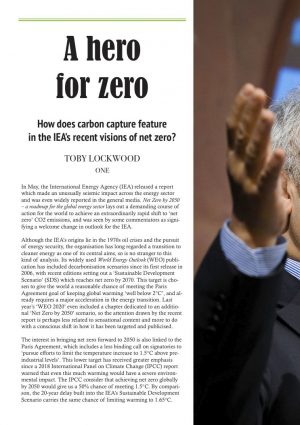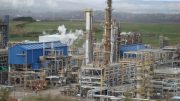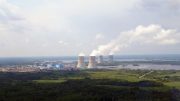 In May, the International Energy Agency (IEA) released a report which made an unusually seismic impact across the energy sector and was even widely reported in the general media. Net Zero by 2050 – a roadmap for the global energy sector lays out a demanding course of action for the world to achieve an extraordinarily rapid shift to ‘net zero’ CO2 emissions, and was seen by some commentators as signifying a welcome change in outlook for the IEA.
In May, the International Energy Agency (IEA) released a report which made an unusually seismic impact across the energy sector and was even widely reported in the general media. Net Zero by 2050 – a roadmap for the global energy sector lays out a demanding course of action for the world to achieve an extraordinarily rapid shift to ‘net zero’ CO2 emissions, and was seen by some commentators as signifying a welcome change in outlook for the IEA.
Although the IEA’s origins lie in the 1970s oil crises and the pursuit of energy security, the organisation has long regarded a transition to cleaner energy as one of its central aims, so is no stranger to this kind of analysis. Its widely used World Energy Outlook (WEO) publication has included decarbonisation scenarios since its first release in 2006, with recent editions setting out a ‘Sustainable Development Scenario’ (SDS) which reaches net zero by 2070. This target is chosen to give the world a reasonable chance of meeting the Paris Agreement goal of keeping global warming ‘well below 2°C’, and already requires a major acceleration in the energy transition. Last year’s ‘WEO 2020’ even included a chapter dedicated to an additional ‘Net Zero by 2050’ scenario, so the attention drawn by the recent report is perhaps less related to sensational content and more to do with a conscious shift in how it has been targeted and publicised.
The interest in bringing net zero forward to 2050 is also linked to the Paris Agreement, which includes a less binding call on signatories to ‘pursue efforts to limit the temperature increase to 1.5°C above pre-industrial levels’. This lower target has received greater emphasis since a 2018 International Panel on Climate Change (IPCC) report warned that even this much warming would have a severe environmental impact. The IPCC consider that achieving net zero globally by 2050 would give us a 50% chance of meeting 1.5°C. By comparison, the 20-year delay built into the IEA’s Sustainable Development Scenario carries the same chance of limiting warming to 1.65°C.
As a growing number of – mostly high-income – countries have responded by proposing or legislating commitments to achieve either net-zero carbon or greenhouse gas emissions by 2050, it is no surprise that the IEA has put the goal increasingly under the spotlight. However, completely decarbonising society in just 30 years will require an unprecedented level of investment and political will even from these prosperous nations. For emerging economies, many of them still heavily reliant on fossil fuels and undergoing rapid economic growth, net zero is an even taller order.
Carbon capture, utilisation and storage (CCUS) is a technology which frequently features heavily in ambitious decarbonisation scenarios, despite its relatively limited use to date. This seemingly indispensable role is often attributed to the wide range of options the technology brings to the table, including its ability to cut emissions from industries with few alternative solutions, such as cement; its role in producing low-carbon hydrogen; and, perhaps most importantly, its ability to permanently remove CO2 from the atmosphere – thus offsetting any of remaining emissions.
From a starting point of only around 50 million tonnes of CO2 captured annually in 2020, the IEA’s latest Sustainable Development Scenario calls for this rate to grow to over 10 billion tonnes in a net-zero 2070, passing through 5.6 billion tonnes of CO2 per year in 2050. Most of this CO2 is stored in deep rock formations, although a small amount is used to make synthetic fuels and other carbon-based products.
So, how does this climate mitigation technology fare in the more urgent scenario released last month? The total amount of CO2 captured in 2050 is increased to 7.6 billion tonnes, making for a much more rapid roll-out, but ultimately reaching net zero with significantly less CCUS. Interestingly, the IEA’s earlier and less-heralded ‘net zero by 2050’ scenario, included in last year’s World Energy Outlook, still called for over 10 billion tonnes of CO2 to be captured in 2050, so the recent report does seem to represent a somewhat reduced role for the technology, at least over this time period.
On the other hand, carbon capture is applied in largely the same pattern as in previous IEA scenarios, across a diverse range of applications. The technology mops up around 3.5 billion tonnes of CO2 emissions still produced by fossil fuels in 2050, which are associated with heavy industry (cement, steel, and chemical production), hydrogen production, and some remaining coal and gas power plants. Although the total capacity of capture-equipped power plants is similar to the level reached when the Sustainable Development Scenario hits net zero, the amount of energy they generate is significantly reduced, so much less CO2 is produced.
Hydrogen tends to be widely used as a low-carbon fuel for heating and transport in net-zero scenarios, as well fuelling power plants which act as clean back-up to intermittent renewables. Low-carbon hydrogen can be made either from fossil fuels while capturing the CO2 produced, or by splitting water using renewable electricity (electrolysis); IEA scenarios typically call on these technologies in roughly equal proportions. The total of 520 million tonnes of low-carbon hydrogen required in the ‘net zero by 2050’ scenario (including over 200 million tonnes using CO2 capture) is similar to the amount used by 2070 in the Sustainable Development Scenario, and accounts for a much bigger proportion of the total fossil CO2 captured in 2050. In other words, the accelerated decarbonisation has clearly not dented the need for this future fuel, but the pace of expansion is nearly doubled as a result.
The biggest winning variety of CO2 capture technology in the recent report is probably direct air capture – a technology which processes ordinary air to remove the low ambient concentrations of CO2. While last year’s Sustainable Development Scenario sees only 100 million tonnes of CO2 captured in this way by 2050 (most of which is converted to synthetic fuels), the new scenario includes over six times this total. Given that this technology is only set to be demonstrated at large-scale for the first time in around 2025, this equates to an enormous scale-up in less than 30 years. However, it is still less than the final level of 800 million tonnes reached by the delayed net zero scenario in 2070.
The other main method of removing CO2 from the atmosphere is bio-energy with CCS (BECCS), in which sustainably grown plants are used to produce energy and the resulting CO2 captured. This approach sees roughly similar levels of expansion by 2050 in the two scenarios, but it is again much less relied upon in their final visions of net zero, as the Sustainable Development Scenario then ramps up its deployment three-fold to reach 300 million tonnes in 2070.
In short, a major difference between the two reports is the extent to which they rely on both types of ‘negative emissions’ to balance the books; net zero in 2050 has close to two billion tonnes compared to nearly three in the Sustainable Development Scenario.
This likely reflects the constraints of a more rushed transition: carbon removal technologies are already ramped up as fast as possible, so any remaining emissions have to be cut faster in order to match the removals in time for the earlier deadline. Regardless of exactly how the numbers break down, there is no doubt that CO2 capture technologies have a hugely significant part to play in reaching net zero in the timescales required by the Paris Agreement.
In fact, the IEA’s own comparison of its latest ‘2050’ scenario with the IPCC’s ‘1.5°C scenarios’ indicates that the level of CO2 capture is actually relatively low, along with – as we have seen – comparatively high reliance on hydrogen and lower use of bio-energy.
It is also worth noting that net zero is not the end of the story. If the global transition is then able to continue into net negative emissions – removing more CO2 from the atmosphere than we emit – even a 2070 target may not be too late to bring warming down to 1.5°C. For this ‘clean-up job’, carbon capture will again be at the fore.
Toby Lockwood





